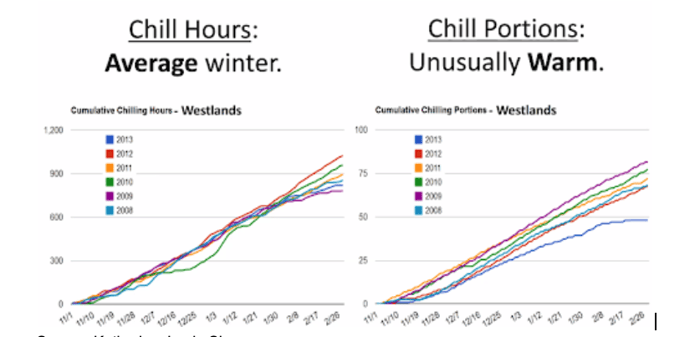2025 California Pistachio Chill Report
In this post, we'll find out how California pistachio chill is progressing in 2025 and answer some of your most frequently asked questions related to chill accumulation, chill portions, and chill hours.
- How is pistachio chill accumulation progressing in 2025?
- What’s the difference between chill hours and chill portions?
- Can you convert chill hours to chill portions?
- What model should be used to track chill? Chill hours or chill portions?
- When should I use chill hours?
- How much chill do pistachios need?
- What are the impacts of low chill accumulation in pistachios?
- Is there anything I can do to improve chill accumulation?
1. How is pistachio chill accumulation progressing in 2025?
Across our network of in-orchard weather stations, we're generally seeing that accumulated chill portions are higher than this time last year.
To see the regional variation in chill accumulation, check out our heat map of California's Central Valley below. It shows the average number of accumulated chill portions from September 1st, 2024, to January 23rd, 2025.
Figure 1. The Central Valley Chill Accumulation Heat Map

How to read the heat map
- Darker blue areas are relatively cooler and have accumulated more chill portions.
- Lighter yellow-green areas are relatively warmer and have accumulated fewer chill portions.
General regional trends
- North Valley has accumulated between 47 to 53 chill portions.
- Mid Valley has accumulated between 48 to 54 chill portions.
- South Valley has accumulated between 45 to 53 chill portions.
- Warmer conditions down in Kings County and Bakersfield have resulted in lower chill accumulation compared to the rest of the valley.
Overall, chill portions are more evenly distributed across the valley than in previous years.
Since the conditions in every orchard vary, the best way to track how your farm is doing against the target is to use on-site weather data.
Semios users can track farm-specific chill accumulations in chill hours and chill portions by logging into the Semios platform. There, you can check daily chill accumulation, view your chill forecast, and compare seasons.
Figure 2. Automatically track your chill hours and portions on the Semios platform, and compare your chill accumulation with the previous season.

How to check your chill data in Semios
- Log in to https://hub.semios.com/
- From the main menu, navigate to Layers > Crop Development then tick the box beside Chill:

- Select your property and click on the Summary or Details view to check your chill hours and portions.
2. What’s the difference between chill hours and chill portions?
In pistachio production, cool temperatures during the dormant season are important for leaf and flower bud development. The cooler temperatures crops rely on can be described as chill hours, chill units, or chill portions (see Understanding Chill in Pistachios).
What are chill hours?
The chill hours model counts the hours a plant is between 32°F and 45°F.
In Figure 3, there are 13 instances where temperatures are between 32°F and 45 °F resulting in 13 accumulated chill hours on this date.
Figure 3. Total Chill Hours Accumulated in One Day
What are chill portions?
Chill portions are a more complex and dynamic model for tracking chill. Since it cannot be calculated in a single equation, the Semios Crop Management Platform automatically calculates and forecasts chill portions and hours for growers on a per-acre basis (see Figure 4).
Figure 4. Growers can track their chill hours and portions on the Semios web app at a per-acre level. They can also view chill forecasts and compare chill accumulation with the previous season.

The general rules the chill portions model follows are:
- Some chill is accumulated at any temperature between 32-54°F but maximum chill is accumulated at 43-47°F.
- The chill accumulated in the most recent two days is provisional and can be negated by subsequent warm temperatures.
Figure 5. Dynamic Chill Portion accumulation in the San Joaquin Valley for 2010-2021. Chill portion requirements are indicated in purple and the blue line shows when chill requirements should be met by (mid February).
3. Can you convert chill hours to chill portions?
No. Although you can calculate both chill hours and chill portions for a given season, there is no correlation between these values.
In Figure 6 we see the calculation of chill hours and chill portions for hundreds of places and dozens of years. In the right panel we can see how on average 1 chill portion corresponds to 14 chill hours. However, at times, 1 chill portion can correspond to as much as 40 and as little as 0 chill hours.
Figure 6. Calculation of chill hours and chill portions
Source: Luedeling & Brown 2011
4. What model should be used to track chill? Hours or portions?
Chill portions have proven more accurate than hours in predicting the effect of insufficient chill on bud break or leaf out.
Let’s use the 2013-2014 season as an example (see Figure 7). In this season, pistachios displayed severe symptoms of insufficient chill. Remember that pistachios need at least 60 chill portions by the time they begin the leaf out process.
The chill hours model did not anticipate this catastrophe while the chill portions model singled out this season as being problematic.
Figure 7. 2013-2014 chill hours vs. chill portions
Source: Katherine Jarvis-Shean
5. When should I use chill hours?
Chill hours should be used with extreme caution, we should not expect to be able to identify when there is going to be insufficient chill using the chill hours model.
6. How much chill do pistachios need?
Each variety has a different chill requirement and this is typically related to how late they wake up.
Figure 8. Chill portions requirements by pistachio variety, calculated using the dynamic model
Click here for detailed information about different crop and variety chill requirements.
7. What are the impacts of low chill accumulation in pistachios?
Pistachio buds that leaf out unevenly can negatively impact synchronization with male trees. In turn, this uneven leaf out will lead to uneven nut development.
Trees with poor chill accumulation tend to have branches that look like “poodle tails” (see Figure 9), where only terminal buds come out.
If chill accumulation is very poor, yields can be severely impacted. However, once the chill requirement has been met, additional chill will not increase yields.
Figure 9. Pistachio trees with ‘poodle tails’ as a result of poor chill accumulation
Source: Katherine Jarvis-Shean
8. Is there anything I can do to improve chill accumulation?
Some growers use hormone analogs, nitrogen cocktails (e.g. calcium ammonium nitrate) and hydrogen cyanamide (aka Dormex). These solutions can be effective in mitigating the effects of insufficient chill.
Dormex is the most common solution worldwide and has been approved for use in pistachios, apples, stone fruit, almonds, berries.
Although these solutions can help with uneven bud break, they may be less effective when chill accumulation is extremely low.
Note that Dormex has phytotoxicity and should be used with caution.
Get In Touch
Want to learn more about how Semios can help you automatically track chill hours and chill portions on your farm? Fill out the form below, and we'll get in touch with more information.
Sources:
UC Davis: Fruit & Nut Crop Chill Portions Requirements
AgFax: 2020 Leaf Out Problems
Related Posts:
Understanding Chill in Pistachios
4 Benefits of In-Canopy Weather Stations in California





.jpg?width=352&name=_MG_6932%20(2).jpg)

